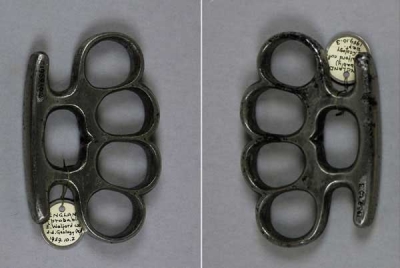Steel knuckledusters (1959.10.2)
 EnglandSteel knuckledusters from England, Europe. Thought to have been collected by Edwin Walford by 1922. Given to the Museum by the Department of Geology, Oxford University Museum of Natural History, in 1959.
EnglandSteel knuckledusters from England, Europe. Thought to have been collected by Edwin Walford by 1922. Given to the Museum by the Department of Geology, Oxford University Museum of Natural History, in 1959.
Hand-fighting weapons have long been associated with cultures of competitive masculinity and this is certainly applicable to this pair of English steel knuckledusters. Knuckledusters have been used in Europe since the gladiatorial bouts of Roman times. Two thousand years later, the basic design had not changed much. Instead of wrapping bits of metal around the knuckles with thongs to increase the force of a punch, the metal has here been formed as series of rings that both harden and protect the fingers. The palm bar allows the force of the blow to be conveyed through the heel of the hand, rather than the fingers.
This pair probably date to the late 19th century. Although this period is now perceived somewhat as a time of domestic peace in Britain, this is far from the truth. Economic hardship in particular fuelled gang violence in many working class communities and those who could not afford firearms armed themselves with knuckledusters, belts, knives and coshes. Urban street fighting in Britain continued into the early and mid 20th century with the onset of agitative political ideologies and it was not until the Prevention of Crime Act of 1953 that such items were officially classed as illegal offensive weapons.





